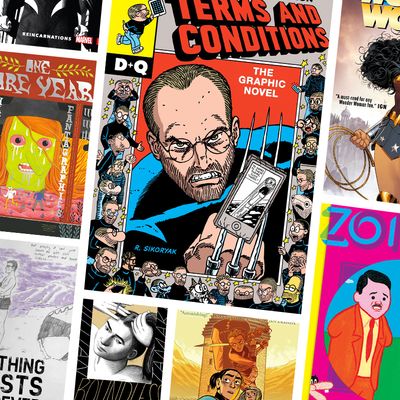
This week, Vulture is looking back at the best releases so far in 2017.

Below, in purely alphabetical order, are 12 of the best bound comics volumes — be they complete graphic novels or collections of serialized chapters — released so far this year. Our criteria for inclusion were that every one of the volumes had to be released in 2017, they had to be the first printing of the material in a bound volume (i.e. no reprints or individual issues of a monthly comic), and they had to have been originally written in English (with the exception of one that has no words at all). Okay, onward to the funny books.
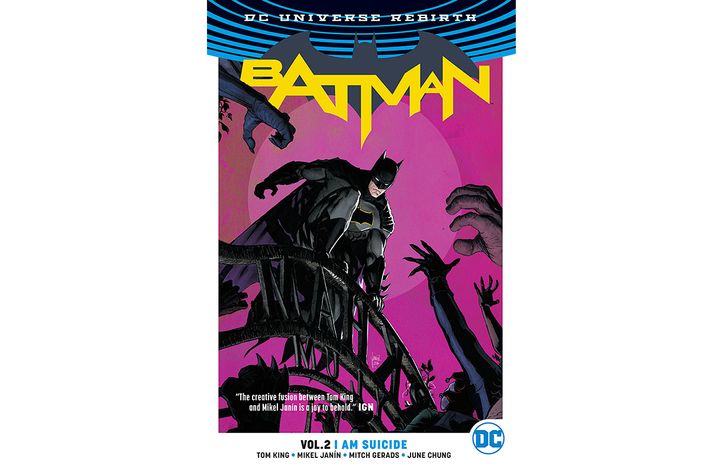
Batman: I Am Suicide by Tom King, Mikel Janín, June Chung, and Mitch Gerads (DC)
Bat fans have been very spoiled for more than a decade, and I Am Suicide only spoils us further. In the mid-aughts, comics god Grant Morrison began a years-long run with the character, after him came the fantastic writer-artist team of Scott Snyder and Greg Capullo, and now we live in the era of one of the greatest up-and-comers in the superhero genre, writer Tom King. Though he doesn’t have one artist doing all of his issues of Batman, all of them are insanely talented in their own way, and this collection of recent issues gives us astounding layouts and pencils from Mikel Janín, vivid colors from June Chung, and a romantic two-parter with all art duties performed by King’s partner from The Sheriff of Baghdad, Mitch Gerads. The story is fascinating, somehow finding new facets of Batsy and his relationships with others after nearly 80 years of continuous publication. I won’t spoil what the title means, but when you get to the explanation, it’ll feel like a Batarang to the gut.
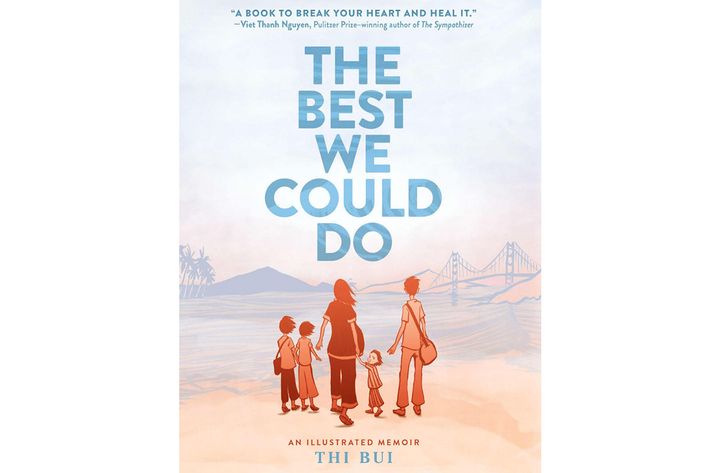
The Best We Could Do by Thi Bui (Abrams)
There’s no way Thi Bui could’ve predicted that her debut work of graphic literature, The Best We Could Do, would end up being the first great political comic of the Trump Era, but it almost indisputably is. That’s not to say it’s in any way preachy — far from it. The book is the story of her Vietnamese-American refugee family, and it resonates in our cacophonous period precisely because it’s so measured and personal. Bui talks about the unique backgrounds of each member of her immigrant kinship network, depicting them in a fully human way that even pro-refugee advocates rarely do. Through evocative inks and passionate character work, Bui makes her family as beautiful as they are flawed, and the temporally zigzagging narrative conveys the impossibility of finding a simple explanation for how the people you love ended up where they are today. Expect this one to show up on school reading lists alongside Fun Home and Persepolis for decades to come.

Boundless by Jillian Tamaki (Drawn + Quarterly)
Jillian Tamaki is no stranger to acclaim, having published beloved works both on her own (SuperMutant Magic Academy) and with her cousin, Mariko (This One Summer). But Boundless should be the book that formally marks her as one of the comics medium’s best up-and-coming auteurs. It’s a strange tome, and deliciously so — its short stories chronicle an array of odd situations ranging from a mysterious audio recording that sparks the creation of a cult to an alternate-reality Facebook where everyone has a doppelgänger whose life you can check in on. This diversity of premises is matched by a diversity of aesthetic styles, from the cleanly formal to the jaggedly emotional. There are comparisons to be made to Jorge Luis Borges’s matter-of-fact surrealism and Adrian Tomine’s slice-of-life vignettes, but this book is passionately and perfectly Tamaki’s own vision.
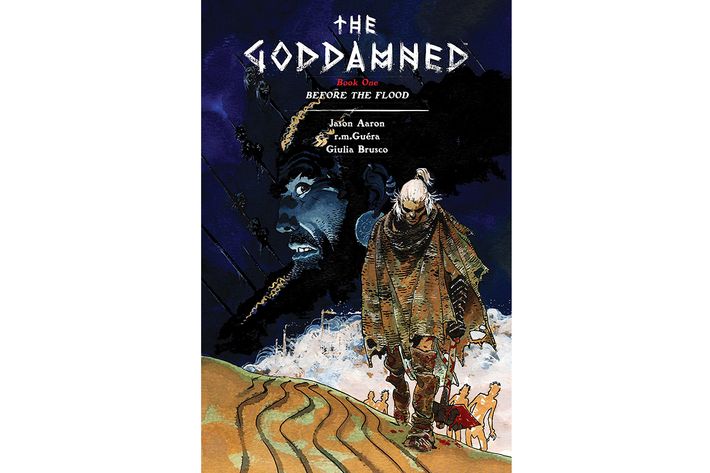
The Goddamned: Before the Flood by Jason Aaron, R.M. Guéra, and Giulia Brusco (Image)
There just aren’t enough barbarian comics these days. Time was, you could pick up an issue of Conan or Kull and find a deep well of tales about hardened bruisers walking the blood-soaked dirt of ancient lands, using just their wits and a blade to kill or save as they saw fit. But that scarcity only makes The Goddamned all the more precious. It’s built on an intriguing premise: We’re following the wanderings of the frustratedly immortal Cain, more than a millennium after he felled Abel. He struggles to figure out what it means for a cursed man to do good, but the best parts of the book aren’t the ones that deal with themes of mission and redemption (well-handled though they are), they’re the ones where Cain just murders the hell out of various nasties from Biblical myth. Imagine some sick guitar riffs and screaming vocals behind this sucker for the full metal experience.
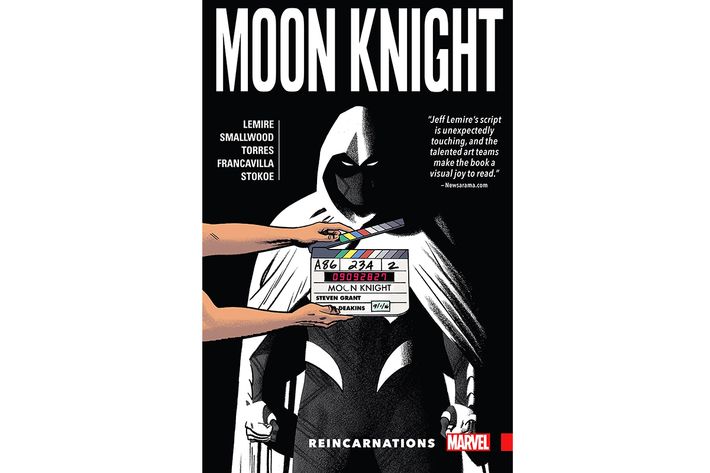
Moon Knight: Reincarnations by Jeff Lemire, Greg Smallwood, Francesco Francavilla, James Stokoe, Wilfredo Torres, Jordie Bellaire, and Michael Garland (Marvel)
It’s rare to read a mainstream superhero comic that feels truly experimental, but perusing the first dozen-plus issues of the latest volume of Moon Knight has been like looking through the work of some undiscovered weirdo genius you found in the micro-press shelf at an obscure comic-book shop. In this volume, we not only get writer Jeff Lemire’s expansive story, penciler Greg Smallwood’s brilliantly innovative layouts, and superstar colorist Jordie Bellaire’s surreal shades; we also get the special treat of seeing guest segments from three of the better pencilers in the game right now: James Stokoe, Wilfredo Torres, and Francesco Francavilla. To make matters weirder, each of those artists are illustrating the splintered adventures of the various alternate personalities of the titular protagonist, all of whom eventually come together for a brain-melting climax. The Lemire-Smallwood-Bellaire run recently concluded, and with it departs one of the best superhero arcs in recent memory.
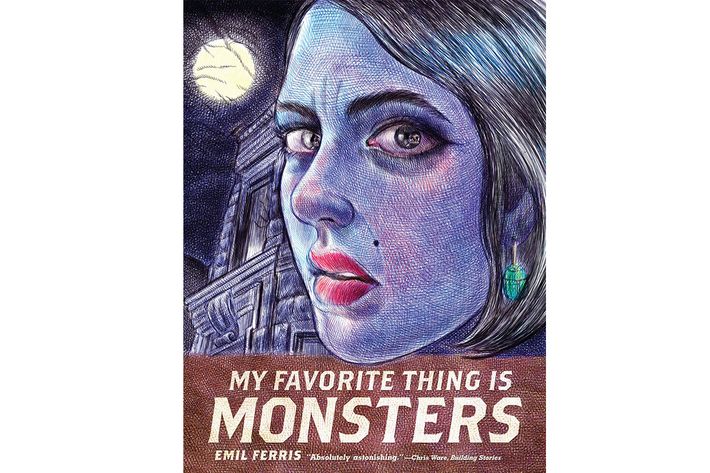
My Favorite Thing Is Monsters Vol. 1 by Emil Ferris (Fantagraphics)
Back in 1977, Dr. Thomas Wolf wrote in the Harvard Educational Review that “reading — in the most general sense — can be thought of as a form of perceptual activity” and that “[t]he reading of words is one manifestation of this activity; but there are many others.” One such manifestation is the reading of traditional comics panels, in which you have to “read” images as well as text. In My Favorite Thing Is Monsters, Emil Ferris presents us with something that resembles comics, but, in its own subtle way, requires an entirely new cognitive method of reading. In order to tell the tale of a preteen girl obsessed with monster movies who investigates her neighbor’s death in 1968 Chicago, Ferris presents us with what are ostensibly the girl’s notebook pages, filled with sketches and words whose proper visual reading order are not always clear. The challenge warps your brain and contributes to an extraordinary literary experience that tackles questions of racial, sexual, cultural, professional, and class identity with aplomb and aesthetic glory. The fact that this is Ferris’s first published graphic novel is only one of the many aspects of the book that will boggle your mind. Welcome to the canon, Ms. Ferris.
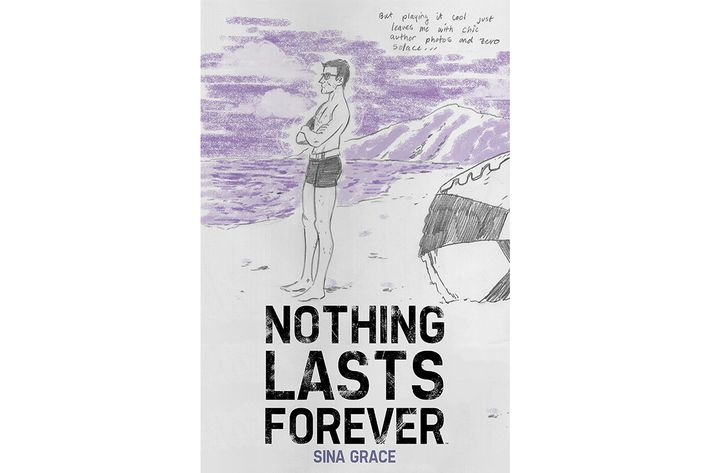
Nothing Lasts Forever by Sina Grace (Image)
For decades, North American sequential art has been cluttered with so-called “autobio” comics — stories about the creator’s own life that at their best are jarringly frank works of memoir, and at their worst are the literary equivalent of amateur pornography. Despite the presence of many drawings of penises, Sina Grace’s Nothing Lasts Forever is firmly the former rather than the latter. The book is ostensibly a sketchbook diary about Grace’s life during a difficult year, but it coheres into an overarching narrative about love, loss, and human bodies. Grace got very sick with a strange illness during the course of his drawing, and he chronicles it with a matter-of-factness that moves us without ever being treacly or sentimental. Even more interesting are Grace’s accounts of his sex and love life, which sheds light on the experience of being a queer man in the age of hookup apps without ever talking down to you or being unnecessarily salacious. The one stumbling block for a lay reader might be the passages in which Grace talks about being jealous of other comics creators, but just insert the names and faces of people you find yourself envying and you’ll see just how relatable this terrific work can be.

One More Year by Simon Hanselmann (Fantagraphics)
In his many, many stories of depressed witch Megg, trainwreck cat Mogg, put-upon bird Owl, and druggie beast Werewolf Jones, Hanselmann has built a corpus of work that stands as some of the best the medium has ever seen. You can be forgiven for underestimating it, as none of the cartooning or narrative is flashy or ostentatious. But don’t mistake subtlety for lack of ambition, as Hanselmann is telling stories about addiction and mental illness in a way that is by turns brutal and delightful. One More Year continues the streak he began with Megahex and Megg and Mogg in Amsterdam, and it might be the best installment yet. The epic stories of Owl’s disastrous fancy dinner and the gang’s trip to the water park will drop your jaw with their awk-comedy and insight into what makes humans cohere and fail. The greatest moment, however, comes when Megg utters the title phrase, providing a whispered cri de coeur to which anyone who has ever seen their life become a mess (which is to say, everybody) can relate. One wishes Megg and her pals would get their shit together, but sadistically, you can’t help but hope they won’t, so we can keep reading Hanselmann’s gentle arias of despair.
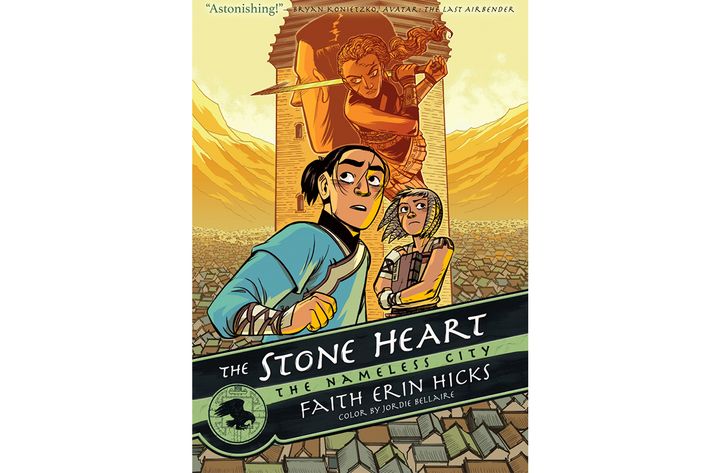
The Stone Heart by Faith Erin Hicks and Jordie Bellaire (First Second)
Speaking of Bellaire, she also provided colors to the words and pencils of the great Faith Erin Hicks for the second volume in their The Nameless City series, and the results are goddamn gorgeous. This young-adult tale is somehow even better than the crackerjack first installment, bringing heartbreak, political intrigue, and ass-kicking to the hands and eyes of youthful readers. Hicks told me she studied Donnie Yen’s fight scenes to pull off her own, and her studying paid off — The Stone Heart has to be one of the most thrilling action comics of the year, all without relying on the crutches of big explosions and whiz-bang laser guns. It’s all human, as are the emotions, conflicts, and resolutions; and the fantasy aspects feel fresh and decidedly non-MacGuffin-esque. The world’s youths are lucky to have this sucker — and so are the grown-ups.
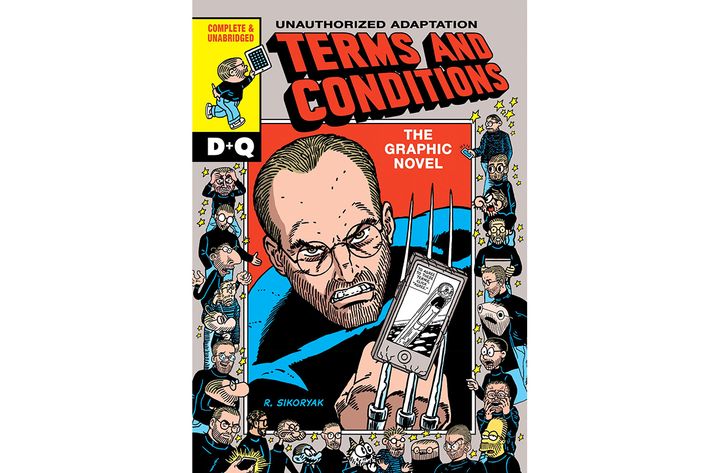
Terms and Conditions: The Graphic Novel by R. Sikoryak (Drawn + Quarterly)
At first, Terms and Conditions strikes you as a novelty item. I mean, come on, a comics adaptation of the iTunes terms and conditions agreement? Maybe good for a quick laugh, and little else. But no, veteran creator R. Sikoryak has used his odd little prompt to craft something wonderful and enlightening. The unique tome follows the travels of Steve Jobs as he utters the T&C verbatim, and every page of the book is done in the style of a different comics artist. The impressions are uncanny, making this a technical achievement of the highest order; the juxtaposition of narrative art and utterly nonnarrative text is a clever mental experiment that tricks your brain into seeing instant connections that are entirely the product of your imagination (… or are they?). But most important, Sikoryak is making a bold and wonderful statement that all comics art — from the commercial superhero-dom of Todd McFarlane to the foundational imaginarium of Winsor McCay; from the NPR-approved highbrow imagery of Alison Bechdel to Richie Rich — is part of one beautiful tapestry. Indeed, this book is that tapestry.
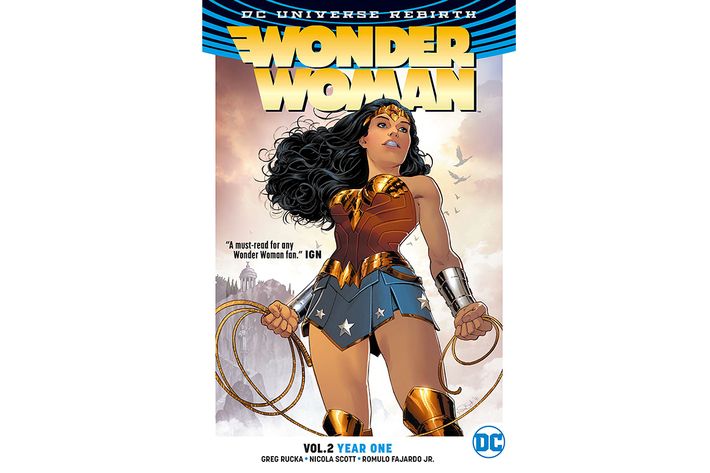
Wonder Woman: Year One by Greg Rucka, Nicola Scott, Bilquis Evely, and Romulo Fajardo Jr. (DC)
It’s no secret that it’s been a good year for Wonder Woman, but that was true even before her solo debut on the big screen. The venerable character has been having some of the best-crafted comics adventures of her decades-long existence within the pages of Wonder Woman, written by Greg Rucka and illustrated by a rotating team of artists. One such team is Nicola Scott, Bilquis Evely, and Romulo Fajardo, Jr., and their duty has been to give life to a revised and streamlined origin story for the titular Diana of Themyscira. The result is a tale that is as evocatively crystal-clear as the skies above Paradise Island, filled with triumph, tragedy, mystery, romance, religion, and stunning moments of tension. Plus, Fajardo got to give Diana a justifiably dark skin tone (she’s Mediterranean, goddammit), which is a nice step in the right direction toward greater representation in the highest echelons of the superhero pantheon.
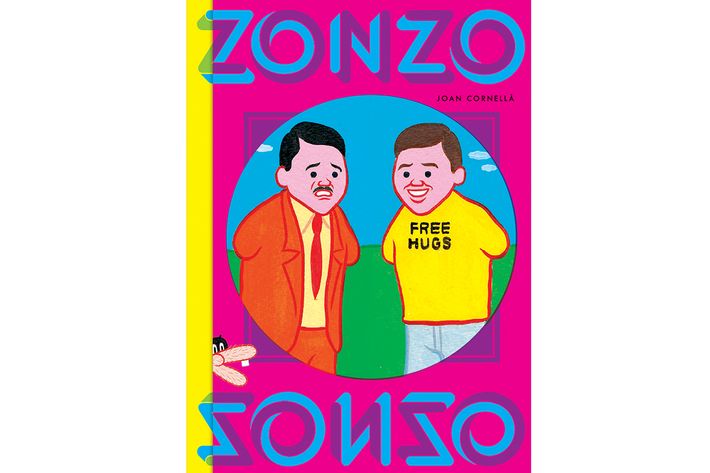
Zonzo by Joan Cornellà (Fantagraphics)
Joan Cornellà’s comics are perversions, and God bless them for that. He’s one of the most unmistakable creators in the sequential art medium today, using wordless, six-panel flash fiction to make your gut giggle as it churns. There’s all kinds of offensive stuff in here, with hunters killing children, mothers having miscarriages, and assorted other material that would make even the boldest teller of an Aristocrats joke blush. And yet, there is method in this filth — Cornellà is able to cut past your defenses and provoke an emotional response (for good or ill) in a way that no other cartoonist working today is able to do. That’s no small achievement, even if it’s one that might get his book banned from the average school library.

